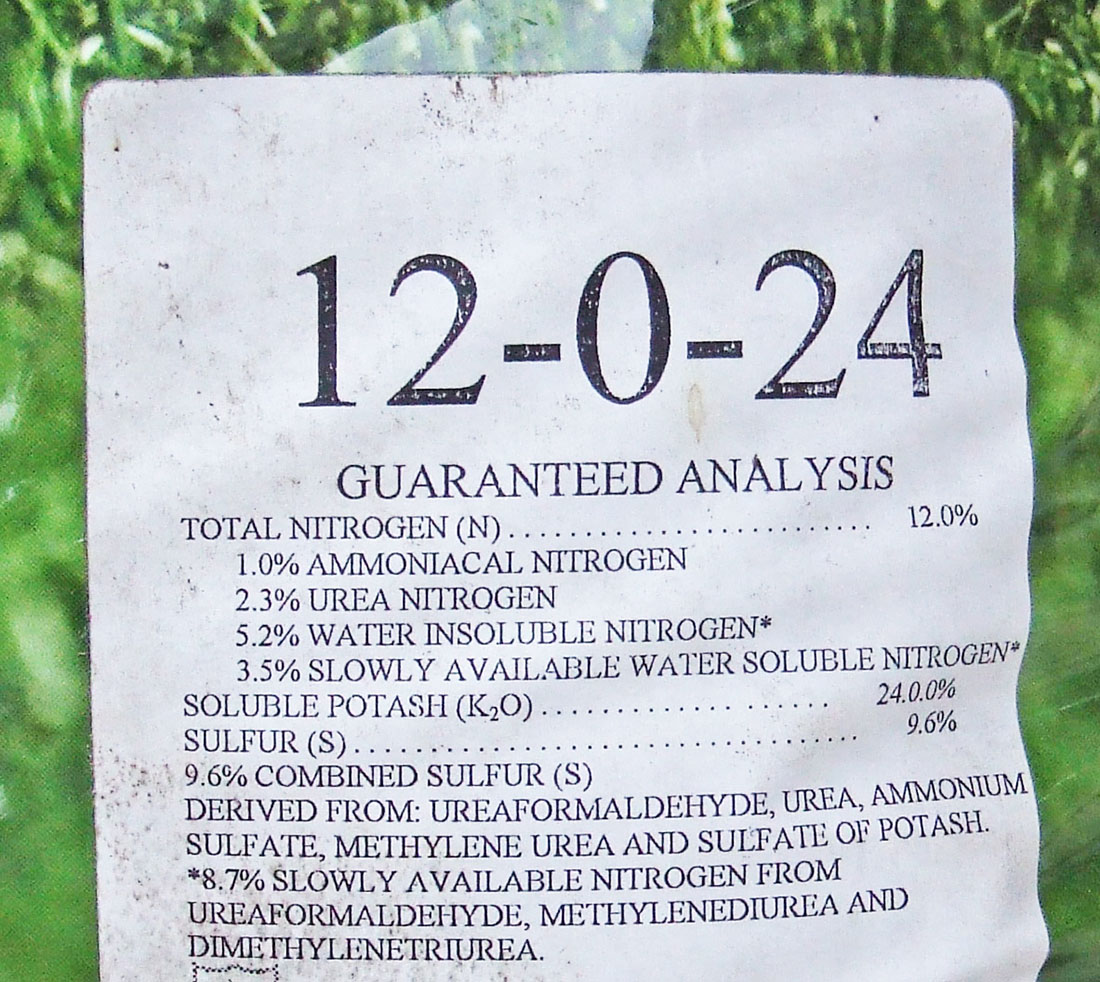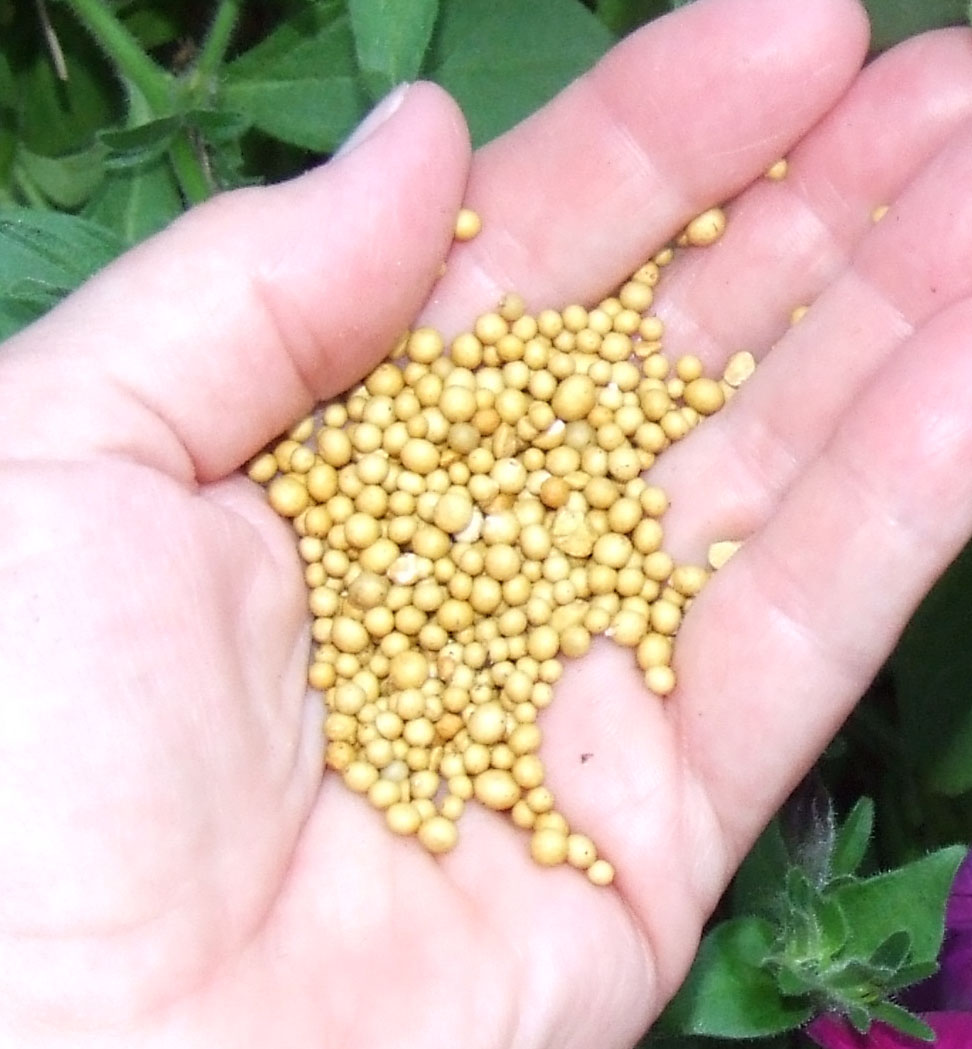
Smart Gardening: Fertilizer Basics for the Smart Gardener
DOWNLOADJanuary 15, 2020 - Rebecca Finneran
Soils that contain adequate amounts of nutrients will enable gardeners to produce healthy plants. The nutrient requirement varies with each species. For certain plants such as trees and shrubs, Michigan soils provide abundant nutrients with little need for supplemental fertilizer. However, in some cases where a plant exhibits a deficiency or the type of plant is known to require higher nutrient levels for success, fertilizers can be applied to enhance growth.
Reading a fertilizer label
Fertilizers differ in the amount of nutrients they contain, and by law, the amounts claimed must be shown on the label (Guaranteed Analysis). Fertilizer analyses are commonly expressed with three numbers, for example, 5-10-5. These numbers are the percentage by weight of each nutrient contained in the product. The first number refers to the percentage of elemental nitrogen (N) present, the second to the percent phosphorus (P) content expressed as P2O5 (phosphate) and the third number to the percent potassium (K) in the form of K2O (potash). For example, an analysis of 5-10-5 contains 5% N, 10% P and 5% K. So, a 50-pound bag of this product would contain 2.5 pounds of nitrogen, 5 pounds of phosphorus and 2.5 pounds of potassium. The rest is filler, such as sand or limestone.

Deciding what type of fertilizer to buy can be confusing, but choosing the right one will help ensure successful plant growth. In general, there are two classes of products available to home gardeners: naturally derived (sometimes called natural organic) and synthetic. Each has different characteristics, variability in cost and availability to the plant.
Synthetic granulated fertilizers
Synthetic, granulated fertilizer is commonly found in garden stores and products may list a specific target “crop” such as a lawn. The formulations are relatively inexpensive and easy to spread using a commercially available fertilizer spreader or by hand as a top dressing. Unless specifically designated as “slow release,” these products are quickly available for plants to take up once watered in. This type of fertilizer is especially useful for short-season, high need crops such as vegetables. Examples of some fast-acting synthetic fertilizers include ammonium sulfate, urea, monoammonium phosphate, diammonium phosphate, triple superphosphate, potassium chloride and sulfate of potash.
Pelletized fertilizer consists of granules that are uniformly coated so they are easy to handle and spread, but tend to be more expensive. Either of these may have slow-release granules incorporated into the products or may be 100% slow release. A slow-release fertilizer has the advantage of being available to the plant over a much longer stretch of time. Some examples of slow-release synthetic fertilizers include sulfur-coated urea, polymer-coated urea and urea formaldehyde. Slow-release fertilizers are often formulated to last three to four months or five to six months.

Soluble fertilizers
Soluble fertilizers are sold as concentrated liquids or solids formulated to be diluted with water, and some are intended to be applied directly to the foliage. Nutrients in this form become available quickly to the plant and are used to augment plant growth for immediate response or correct a deficiency. This very useful type of fertilizer is relatively low cost and most often used in tandem with a slow-release type of fertilizer.

What determines an organic fertilizer?
The term organic as defined by a chemist versus a gardener may not be the same thing. Organic compounds contain the element carbon, which would represent naturally derived sources of fertilizer as well as urea, a synthetically derived fertilizer. Generally speaking, products that are composed of organic matter such as composted animal manure, bone meal or leaf litter are accepted as organic by gardeners.
An advantage of using a naturally derived fertilizer is its ability to release nutrients slowly to plants. This can be an advantage to plants that live for more than one season, such as perennials, woody trees and shrubs. Natural organic fertilizers will not quickly correct a nutrient deficiency and may not supply enough nutrients for crops such as tomatoes that require larger amounts of fertilizer for optimum performance.
The second advantage of using a naturally derived fertilizer is its positive impact on the soil’s ability to hold nutrients, water and air. Because of the time involved in producing these products, they can often be more costly.

|
Common fertilizer analyses |
% N |
% P as P2O5 |
% K as K2O |
Other elements |
|---|---|---|---|---|
|
Urea |
46 |
0 |
0 |
|
|
Ammonium sulfate |
21 |
0 |
0 |
23.7% sulfur |
|
Sulfur coated urea |
35 |
0 |
0 |
21% sulfur |
|
Calcium nitrate |
15 |
0 |
0 |
19.4% calcium, 1.5% magnesium |
|
Blood meal |
12 |
0 |
0 |
|
|
Monoammonium phosphate |
11 |
48 |
0 |
|
|
Diammonium phosphate |
18 |
46 |
0 |
|
|
Triple superphosphate |
0 |
46 |
0 |
|
|
Rock phosphate |
0 |
30-36 |
0 |
|
|
Bone meal |
2.4-5 |
22-28 |
0 |
20-25% calcium |
|
Milorganite |
6 |
2 |
0 |
1.2% calcium, 4% iron, 1% chlorine |
|
Potassium chloride |
0 |
0 |
60-62 |
|
|
Potassium sulfate |
0 |
0 |
50 |
1.2% magnesium, 17.6% sulfur |
|
Sul-po-mag |
|
|
22 |
11.2% magnesium, 22.7% sulfur |
Table developed by Diane Brown, MSU Extension
This publication is supported in part by the Crop Protection and Pest Management Program 2017-70006-27175 from the USDA National Institute of Food and Agriculture. Any opinions, findings, conclusions, or recommendations expressed are those of the author(s) and do not necessarily reflect the view of the U.S. Department of Agriculture.



 Print
Print Email
Email

